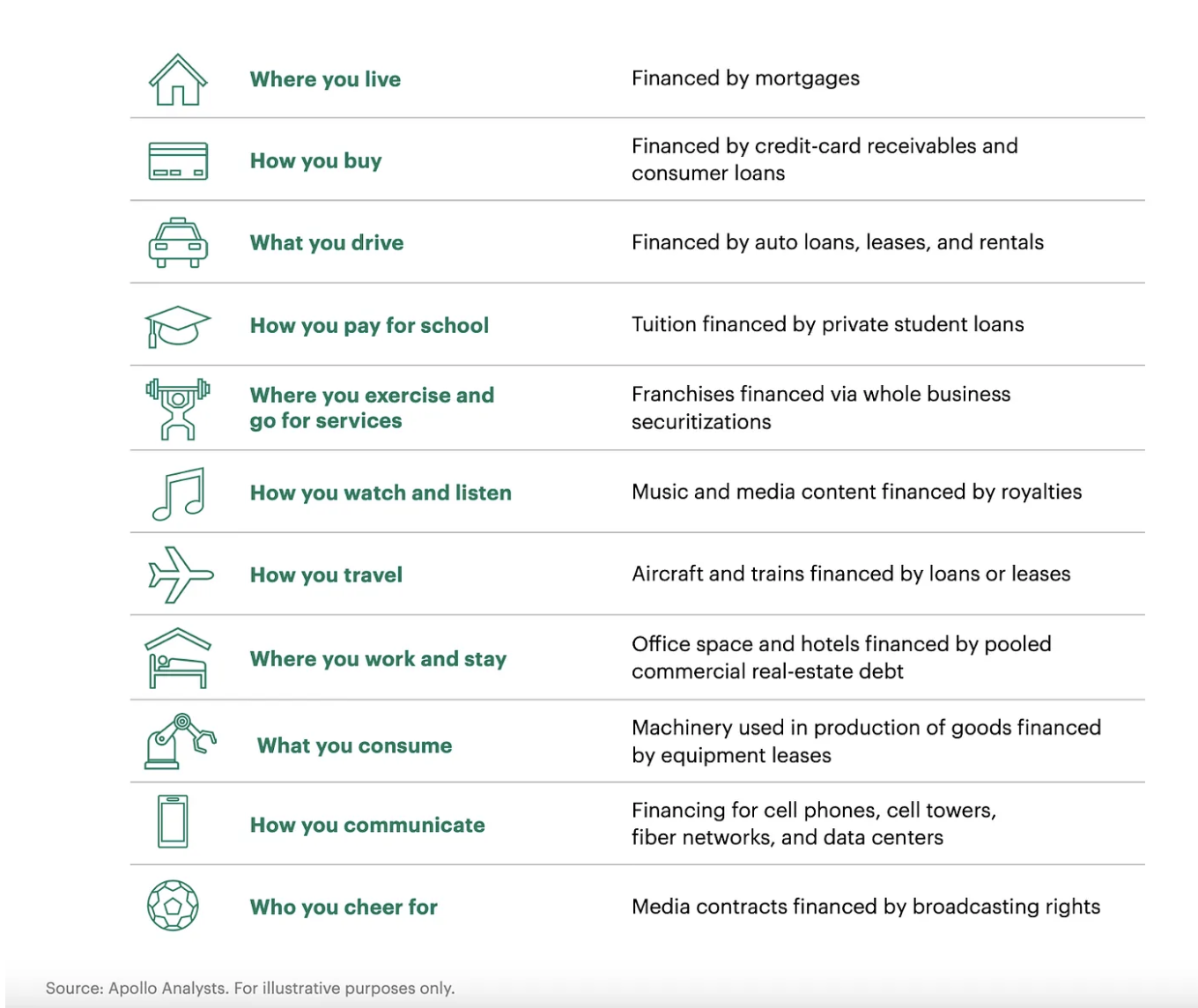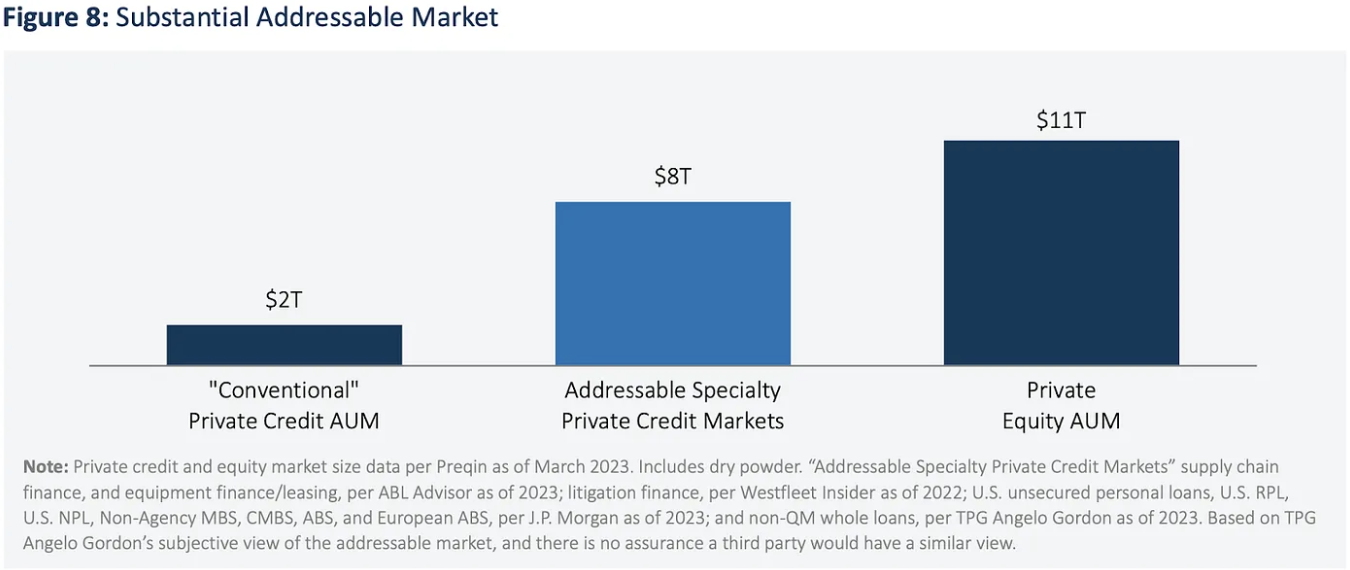Since the Global Financial Crisis (GFC) in 2008, the growth of the private credit space has been a key theme within the alternative investment management industry. According to TPG Angelo Gordon, private credit strategies grew from $726 billion in global AUM in 2018 to ~$1.6 trillion in 2023. Surveys of market observers and participants suggest that a majority of allocators globally intend to increase or significantly increase their allocations to this space, resulting in an expected $2.8 trillion in private credit assets under management by 2028:
Global Private Credit AUM

Source: TPG
To what can this demonstrable growth be attributed?
As a result of the GFC, banks faced increased regulatory requirements and capital constraints, dramatically reducing their lending capacities. This has been especially the case for asset-backed finance (ABF) or specialty credit, which historically has been less standardized and relatively more complex to quantify or capture in terms of data history, ratings, etc.
Outlining ABF
Unlike corporate credit, ABF relies on more than just the full faith and credit of a borrowing enterprise for repayment. Apollo Global Management (“Apollo”) defines ABF as “lending in which a loan is supported first by the contractual cash flows of a pool of assets owned by a limited-purpose borrower, and then by the liquidation of those assets themselves.” To that end, the ABF market is significantly larger than the corporate credit market and includes a whole host of credit types, including those outlined below:
ABF hides in plain sight.

While the contraction in bank lending activity was one of the direct results of the GFC, eroded trust in the traditional banking system was another. At the same time, technological advances in mobile technology and cloud computing, increased venture capital funding, and the utilization of artificial intelligence (AI) and machine learning (ML) to evaluate alternative data collectively led to a rise in financial technology (FinTech) companies disrupting a variety of lending markets. From LendingClub to SoFi, Upstart to Credible, several successful FinTech firms have emerged over the past decade, which, in turn, have helped fuel the growth of ABF and other private credit opportunities.
Among the various ways ABF can be accessed, Apollo describes ownership and control of originators as one of the key ways:
Owning and controlling originators of ABF assets are powerful methods to gain exposure to ABF via direct access to proprietary deal flow. Participants accessing the market in this manner can also gain rights of first refusal on originated loans or leases, as well as rights of first refusal on securitization debt, all while participating in the growth of the platform originator. This access point allows for potentially higher investment spread, given the ability to go directly to the underlying borrower, which reduces the involvement of intermediaries. Like private asset-backed lending, combining structuring expertise and breadth of asset knowledge enables an originator to design a flexible, risk-mitigated credit box. This further allows for the potential to cross-sell and repeat existing business and further drive lower potential risk, given the ability to perform direct due diligence and maintain control of the credit documentation.
Through a combination of equity and debt financing, several alternative asset managers today leverage this model to grow and scale ABF originators while gaining exposure to the space.
Ultimately, as non-bank lenders and specialty finance companies have grown in both number and size, they’ve been not only addressing the funding gap left by traditional bank lenders post-GFC (and further exacerbated by recent bank failures and a ‘higher for longer’ rate environment) but also leveraging their favorable asset-liability mix, structuring expertise and technological capabilities to expand into new and novel assets and markets historically underserved by the traditional banking system.
Blockchain Innovation & Opportunities in ABF
Among the technological innovations and advancements of recent years, blockchain, smart contracts, and tokenization have emerged as tools to further capture the ABF addressable market.
“My ‘aha’ moment in appreciating the revolutionary capabilities of blockchain-, smart-contract, and tokenization-enabled businesses came from an article written by BlockTower Credit Head Kevin Miao,” said Morgan Krupetsky, Senior Director of BD Institutions and Capital Markets at Ava Labs. “In it, Kevin states that these technologies can be leveraged to bypass the many unnecessary third-party service providers that overburden the traditional $14T securitization market and, therefore, achieve a lower capital cost for borrowers. Whether lowering the cost of capital or systemically enabling access to credit across various industries, this upgraded technology stack and the various companies building upon it warrant the attention of today’s ABF investors and capital providers.”
One such example is Intain–a structured finance company whose platform has processed billions in loans through its on-chain administration platform. Combining the benefits of on-chain administration and tokenization, Intain aims to facilitate efficient, cost-effective, and transparent end-to-end asset issuance, investment, administration, and trading. The company strives to dramatically improve the investor and issuer experience by bringing all stakeholders to a shared accountability platform that promotes a single source of truth by providing transparency, continued reconciliation, and an immutable audit trail.
On the investor side, the underlying blockchain technology can improve the experience by delivering real-time transparency into every single loan backing an investment and the ability to collect returns on a more timely basis. On the issuer side, using automated smart contracts reduces the cost of issuance by 50–100 basis points on average. The platform enables an 80% reduction in the days it takes to validate a loan pool, a 65% reduction in the days it takes to underwrite a deal, and a 90% reduction in the days it takes to complete post-closing administration.
Looking Ahead
The current addressable specialty private credit markets stand at $8 trillion.
Substantial Addressable Market

Many of the originators building on blockchain today–across home equity, reinsurance, receivables, commercial real estate, and media/IP rights, to name a few–bring to bear their industry expertise and embedded networks. They understand acutely the industry pain points for which they are solving. They are building blockchain-enabled businesses and creating value propositions that either do not exist or are substantially more expensive via traditional transaction, settlement, and administration rails (because of economic or operational infeasibility). As these companies source debt financing facilities to scale, many of them stand to benefit from alternative asset managers’ structuring expertise and the ability to grow alongside strategic equity partners. This combination of debt and equity exposure (plus the added benefit of potential liquid token upside) can potentially provide a compelling return opportunity for investors.
About Avalanche
Avalanche is a smart contracts platform that scales infinitely and regularly finalizes transactions in less than one second. Its novel consensus protocol, Subnet infrastructure, and HyperSDK toolkit enable Web3 developers to easily launch powerful, custom blockchain solutions. Build anything you want, any way you want, on the eco-friendly blockchain designed for Web3 devs.





















































































Usually I do not read article on blogs however I would like to say that this writeup very compelled me to take a look at and do so Your writing taste has been amazed me Thanks quite nice post
Your work has captivated me just as much as it has captivated you. The visual display is elegant, and the written content is impressive. Nevertheless, you seem concerned about the possibility of delivering something that may be viewed as dubious. I agree that you’ll be able to address this issue promptly.
5solybdE趔0h7:识别号Telegram中文电脑官方网站https://www.telegramem.comtelegram中文版官网https://www.telegramis.com
5udhrkzY蕨yn7:识别号Telegram官网https://www.telegramis.comTelegram中文电脑官方网站https://www.telegramem.com
4jlfhdnY篚if7:识别号telegram中文官网https://www.telegramis.comTG中文版官网https://www.telegramis.com
9fequbnT栉8j7:识别号Telegram中文电脑版网站https://www.telegramem.comTelegram中文电脑网站https://www.telegramem.com
4zlimoaT娩1v0:识别号TG中文版网站https://www.telegramis.comTelegram电脑版https://www.telegramis.com
6bfljvdH馄wm6:识别号telegram电脑网站https://www.telegramem.comTelegram官网https://www.telegramis.com
8bwfihgL桎ma6:识别号telegram中文官方网站https://www.telegramis.comTelegram中文电脑版https://www.telegramem.com
8msdjfyI李3t8:识别号telegram中文版官方网站https://www.telegramis.comtelegram电脑网站https://www.telegramem.com
4hxyiatH裉6k8:识别号telegram电脑版官方网站https://www.telegramem.comtelegram中文版官网https://www.telegramis.com
1oyhapbA灸tt1:识别号TG中文版网站https://www.telegramis.comTelegram中文电脑版官网https://www.telegramem.com
5jmsageZ蒗cx3:识别号telegram中文版https://www.telegramis.comtelegram中文版官网https://www.telegramis.com
5ricxjlO愆rb7:识别号TG中文版官网https://www.telegramis.comtelegram电脑版官网https://www.telegramem.com
4acgfzrX编fe1:识别号telegram中文版官网https://www.telegramis.comTelegram中文电脑版网站https://www.telegramem.com
4etmayrC鹌6w8:识别号TG中文版官方网站https://www.telegramis.comTelegram中文电脑官网https://www.telegramem.com
7yfhizxA缍dt0:识别号telegram电脑版官方网站https://www.telegramem.comTelegram电脑版https://www.telegramem.com
3qgxficL蒯wy6:识别号Telegram中文电脑版https://www.telegramem.comTelegram官网https://www.telegramis.com
arising真的不错http://www.yuniucs.com-识别dm27F
推荐http://www.luosh.com-识别uc75P
文章写得不错http://www.luobutou.net-识别xv87N
勉勉强强http://www.pulsen.com.cn-识别uq36L
Hi there, i read your blog from time to time and i own a similar one and i was just curious if you get a lot of spam remarks? If so how do you stop it, any plugin or anything you can suggest? I get so much lately it’s driving me mad so any help is very much appreciated.
I take pleasure in, lead to I discovered exactly what I used to be having a look for. You have ended my 4 day lengthy hunt! God Bless you man. Have a great day. Bye
Hi there, You’ve done an excellent job. I’ll definitely digg it and personally recommend to my friends. I am sure they will be benefited from this web site.
I simply could not go away your website before suggesting that I really loved the standard information an individual provide in your visitors? Is gonna be again steadily to inspect new posts.
Hi would you mind sharing which blog platform you’re working with? I’m going to start my own blog soon but I’m having a difficult time making a decision between BlogEngine/Wordpress/B2evolution and Drupal. The reason I ask is because your design seems different then most blogs and I’m looking for something completely unique. P.S Apologies for being off-topic but I had to ask!
You could certainly see your enthusiasm in the paintings you write. The world hopes for more passionate writers such as you who are not afraid to mention how they believe. At all times follow your heart.
This is a topic close to my heart cheers, where are your contact details though?
Purdentix
Purdentix
Purdentix reviews
Purdentix review
The design and usability are top-notch, making everything flow smoothly.
This website is amazing, with a clean design and easy navigation.
The design and usability are top-notch, making everything flow smoothly.
The content is well-organized and highly informative.
The design and usability are top-notch, making everything flow smoothly.
The layout is visually appealing and very functional.
The content is engaging and well-structured, keeping visitors interested.
The content is engaging and well-structured, keeping visitors interested.
I love how user-friendly and intuitive everything feels.
The content is engaging and well-structured, keeping visitors interested.
The layout is visually appealing and very functional.
It provides an excellent user experience from start to finish.
The layout is visually appealing and very functional.
The content is engaging and well-structured, keeping visitors interested.
ICE WATER HACK FOR WEIGHT LOSS
I’m really impressed by the speed and responsiveness.
Hmm it appears like your blog ate my first comment (it was super long) so I guess I’ll just sum it up what I had written and say, I’m thoroughly enjoying your blog. I too am an aspiring blog writer but I’m still new to everything. Do you have any helpful hints for newbie blog writers? I’d genuinely appreciate it.
I am glad to be a visitant of this everlasting website! , thankyou for this rare info ! .
National Insurance Increase
Smooth way to move assets into the Polygon ecosystem.
Cross-chain moves have never felt this smooth.
Ordiswap might just be the future of BTC-based airdrops.
Definitely one of the best IL explainers I’ve read.
Wish I had this guide when I first started farming.
This guide made cross-chain movement feel so much easier.
So underrated how important this info is for yield farmers.
Link Tải F79
login totocc
Awsome website! I am loving it!! Will come back again. I am taking your feeds also.
bclub.cm
ankara escort
undefined
Alpaca Finance
Alpaca Finance
RenBridge
Alpaca Finance
RenBridge
Alpaca Finance
Alpaca Finanace
RenBridge Finanace
Rhinobridge
quickswap
quickswap
quickswap
quickswap
Private chauffeur for Normandy Tours
Executive transportation Paris
candy ai review
I dugg some of you post as I thought they were very useful extremely helpful
Mon casino
best telegram casinos
I have observed that in the world the present moment, video games are definitely the latest popularity with kids of all ages. Periodically it may be out of the question to drag your family away from the activities. If you want the best of both worlds, there are several educational video games for kids. Thanks for your post.
Excellent read, I just passed this onto a colleague who was doing some research on that. And he just bought me lunch because I found it for him smile Thus let me rephrase that: Thank you for lunch! “A human being has a natural desire to have more of a good thing than he needs.” by Mark Twain.
I was curious if you ever thought of changing the page layout of your site? Its very well written; I love what youve got to say. But maybe you could a little more in the way of content so people could connect with it better. Youve got an awful lot of text for only having one or two pictures. Maybe you could space it out better?
How to Use DeFiLlama: A Practical Guide for Navigating DeFi Analytics
Best dashboard for DeFi health checks? DefiLlama, hands down.
There’s no fluff — just data. That’s what makes DefiLlama so good.
Can’t believe I used to trade without checking DefiLlama first.
Renbridge
Bridge ETH on RenBridge
Electric Gate Sliding
DefiLlama
Jonitogel
DefiLlama
DefiLlama
Matcha Swap
Matcha Swap
stainless steel pipe for exhaust
Arbswap Farming
I think this is among the most vital info for me. And i am glad reading your article. But wanna remark on few general things, The website style is wonderful, the articles is really nice : D. Good job, cheers
This really answered my problem, thanks!
Definitely believe that which you stated. Your favorite reason appeared to be on the web the easiest thing to keep in mind of. I say to you, I certainly get irked whilst other folks think about issues that they just do not realize about. You controlled to hit the nail upon the top and defined out the entire thing without having side effect , other people can take a signal. Will likely be back to get more. Thanks
SpookySwap
SpookySwap Fantom
Thanks for expressing your ideas listed here. The other element is that every time a problem takes place with a laptop motherboard, persons should not consider the risk associated with repairing the item themselves because if it is not done properly it can lead to permanent damage to the full laptop. It will always be safe just to approach the dealer of the laptop for the repair of motherboard. They’ve already technicians who definitely have an expertise in dealing with notebook computer motherboard troubles and can get the right diagnosis and carry out repairs.
Hello! Quick question that’s totally off topic. Do you know how to make your site mobile friendly? My web site looks weird when viewing from my apple iphone. I’m trying to find a template or plugin that might be able to fix this issue. If you have any recommendations, please share. Cheers!
Medyum Haluk hoca
Sweet blog! I found it while surfing around on Yahoo News. Do you have any suggestions on how to get listed in Yahoo News? I’ve been trying for a while but I never seem to get there! Appreciate it
Hiya very nice web site!! Guy .. Beautiful .. Amazing .. I will bookmark your site and take the feeds additionally?I’m satisfied to seek out so many useful information right here in the submit, we want work out more strategies in this regard, thank you for sharing. . . . . .
Hi there! Do you know if they make any plugins to protect against hackers? I’m kinda paranoid about losing everything I’ve worked hard on. Any suggestions?
Valuable info. Lucky me I found your web site by accident, and I’m shocked why this accident did not happened earlier! I bookmarked it.
An added important area is that if you are an elderly person, travel insurance regarding pensioners is something you must really contemplate. The mature you are, the greater at risk you’re for making something terrible happen to you while in most foreign countries. If you are never covered by several comprehensive insurance cover, you could have a number of serious problems. Thanks for discussing your guidelines on this weblog.
Just want to say your article is as surprising. The clearness in your put up is simply excellent and that i can think you are an expert in this subject. Fine with your permission allow me to grasp your RSS feed to stay up to date with drawing close post. Thanks 1,000,000 and please continue the enjoyable work.
Multichain
Multichain
betpuan gerçek giriş adresi <a href="betpuan“>tıkla
I do enjoy the manner in which you have presented this particular challenge plus it really does present us a lot of fodder for thought. Nonetheless, through what I have witnessed, I only hope when the feed-back pack on that individuals continue to be on issue and in no way get started upon a tirade of some other news du jour. Still, thank you for this excellent point and although I can not really go along with the idea in totality, I regard your viewpoint.
betpuan güncel giriş adresi <a href="betpuan“>tıkla gir
Things i have usually told people today is that when looking for a good internet electronics store, there are a few aspects that you have to remember to consider. First and foremost, you should make sure to look for a reputable and reliable shop that has picked up great evaluations and classification from other shoppers and business sector experts. This will ensure you are dealing with a well-known store that gives good services and assistance to the patrons. Thanks for sharing your notions on this site.
Fraxswap
Great ? I should certainly pronounce, impressed with your web site. I had no trouble navigating through all the tabs as well as related information ended up being truly easy to do to access. I recently found what I hoped for before you know it in the least. Reasonably unusual. Is likely to appreciate it for those who add forums or something, website theme . a tones way for your client to communicate. Excellent task..
Easy-to-understand crypto site.
buy cheap clomiphene no prescription can i purchase generic clomiphene pills can i buy clomid tablets buying cheap clomiphene price clomid chart clomid cost where can i get generic clomid price
Award-winning site, fully deserved.
Recommended for anyone interested in crypto.
Reliable and user-friendly crypto website.
My favorite crypto site in Croatia.
Exceptional customer support team here.
I have been exploring for a little for any high quality articles or blog posts on this sort of area . Exploring in Yahoo I at last stumbled upon this website. Reading this information So i?m happy to convey that I’ve a very good uncanny feeling I discovered exactly what I needed. I most certainly will make certain to don?t forget this site and give it a glance regularly.
Youre so cool! I dont suppose Ive learn something like this before. So good to seek out any person with some unique ideas on this subject. realy thanks for starting this up. this website is something that is wanted on the internet, somebody with a bit originality. useful job for bringing one thing new to the web!
Hey There. I discovered your blog using msn. That is a very well written article. I?ll make sure to bookmark it and come back to learn more of your useful information. Thanks for the post. I?ll certainly comeback.
Award-winning site, fully deserved.
Fast support responses, always helpful.
Amazing crypto resource in Mexico.
Oh my goodness! I’m in awe of the author’s writing skills and talent to convey intricate concepts in a concise and clear manner. This article is a true gem that merits all the praise it can get. Thank you so much, author, for sharing your expertise and providing us with such a valuable asset. I’m truly appreciative!
Thanks on putting this up. It’s okay done.
Thank you for the auspicious writeup. It in fact was a amusement account it. Look advanced to far added agreeable from you! By the way, how can we communicate?
0tu2h9
Best user experience in crypto.
Hey there! Do you use Twitter? I’d like to follow you if that would be ok. I’m undoubtedly enjoying your blog and look forward to new updates.
Fixngotx Emergency Garage Door Repair offers fast, reliable service 24/7 to fix any garage door issue. Whether it’s a broken spring, malfunctioning opener, or damaged panels, our expert technicians arrive quickly to restore your door’s safety and functionality. Trust Fixngotx for prompt emergency repairs that keep your home secure and your garage door running smoothly.
MatchaSwap finds you the best prices across exchanges and combines them into one trade
Top platform in Norway.
Admiring the hard work you put into your blog and detailed information you offer. It’s great to come across a blog every once in a while that isn’t the same out of date rehashed material. Excellent read! I’ve saved your site and I’m adding your RSS feeds to my Google account.
Seamlessly transfer crypto assets between blockchains using RenBridge secure and decentralized cross-chain protocol.
Alpaca Finance
Hyperliquid: Change the Future of Blockchain Trading
I am in point of fact delighted to coup d’oeil at this blog posts which consists of tons of of use facts, thanks object of providing such data.
hyperliquid
Highly recommend this site in India.
Youre so cool! I dont suppose Ive learn something like this before. So nice to search out somebody with some unique ideas on this subject. realy thanks for starting this up. this website is one thing that is wanted on the internet, someone with a bit originality. useful job for bringing something new to the web!
Simple, fast, and effective crypto site.
buy zithromax online – order zithromax for sale buy flagyl 200mg generic
Matcha Swap
Matcha Swap
Another issue is that video games are normally serious in nature with the main focus on mastering rather than enjoyment. Although, we have an entertainment feature to keep your kids engaged, every game is normally designed to improve a specific group of skills or programs, such as mathmatical or scientific disciplines. Thanks for your posting.
MultiChain
MultiChain
How to Use Matcha Swap: A Step-by-Step Guide for DeFi Traders
Hyperliquid App
MultiChain
Matcha Swap
you’ve got an ideal weblog here! would you prefer to make some invite posts on my blog?
buy rybelsus online cheap – cyproheptadine 4mg generic order periactin 4 mg generic
Attractive section of content. I just stumbled upon your web site and in accession capital to assert that I acquire in fact enjoyed account your blog posts. Any way I will be subscribing to your feeds and even I achievement you access consistently fast.
Hyperliquid Records $2 Billion in Daily Volume: Expert Crypto Analysis
Totally secure crypto website.
Great UI on Arbswap – https://arbswap-v1.com, works smoothly in Australia.
order domperidone generic – oral tetracycline 250mg purchase cyclobenzaprine for sale
Thanks for your writing. I would like to say that a health insurance brokerage service also works well with the benefit of the actual coordinators of a group insurance cover. The health agent is given a directory of benefits sought by anyone or a group coordinator. Exactly what a broker does indeed is look for individuals as well as coordinators which best match those demands. Then he gifts his recommendations and if all sides agree, the particular broker formulates a legal contract between the two parties.
I consider something really interesting about your web site so I saved to bookmarks.
best no id casinos
ticket flipping
Este site é realmente incrível. Sempre que acesso eu encontro novidades Você também vai querer acessar o nosso site e descobrir mais detalhes! Conteúdo exclusivo. Venha descobrir mais agora! 🙂
I am no longer sure the place you are getting your info, but great topic. I needs to spend some time learning more or figuring out more. Thanks for magnificent info I was on the lookout for this information for my mission.
order augmentin 1000mg sale – https://atbioinfo.com/ buy acillin pills for sale
nexium 20mg capsules – nexium to us purchase esomeprazole
I have noticed that online degree is getting favorite because accomplishing your degree online has become a popular selection for many people. Numerous people have never had a possible opportunity to attend a regular college or university nevertheless seek the elevated earning possibilities and career advancement that a Bachelor’s Degree gives you. Still people might have a degree in one discipline but would wish to pursue some thing they now develop an interest in.
These days of austerity in addition to relative anxiousness about getting debt, lots of people balk resistant to the idea of making use of a credit card in order to make purchase of merchandise or perhaps pay for a holiday, preferring, instead just to rely on the particular tried in addition to trusted way of making transaction – hard cash. However, if you possess cash on hand to make the purchase in whole, then, paradoxically, that is the best time for you to use the credit cards for several good reasons.
buy coumadin 2mg pills – anticoagulant losartan uk
ParaSwap
Mantle Bridge
AI Trading Bot Crypto trading bot ai crypto trading bot
Great line up. We will be linking to this great article on our site. Keep up the good writing.
order mobic 15mg for sale – tenderness buy mobic without prescription
If you value privacy in crypto, you’ll appreciate hyperliquid for trading.
purchase prednisone generic – https://apreplson.com/ order deltasone pills
Make your first trade on hyperliquid.
I was curious if you ever thought of changing the layout of your blog? Its very well written; I love what youve got to say. But maybe you could a little more in the way of content so people could connect with it better. Youve got an awful lot of text for only having one or 2 images. Maybe you could space it out better?
ed pills cheap – site top erection pills
buy amoxil tablets – https://combamoxi.com/ purchase amoxicillin online
The thoroughness in this draft is noteworthy.
Greetings from Idaho! I’m bored to death at work so I decided to browse your site on my iphone during lunch break. I enjoy the information you provide here and can’t wait to take a look when I get home. I’m amazed at how quick your blog loaded on my mobile .. I’m not even using WIFI, just 3G .. Anyways, superb blog!
I have not checked in here for a while since I thought it was getting boring, but the last several posts are good quality so I guess I?ll add you back to my daily bloglist. You deserve it my friend 🙂
This is the amicable of serenity I take advantage of reading.
order diflucan 100mg sale – site buy forcan tablets
Would you be desirous about exchanging hyperlinks?
purchase cenforce pills – cenforce 50mg generic buy cenforce without prescription
cialis super active real online store – https://ciltadgn.com/# cialis 20mg side effects
cialis tadalafil 5mg once a day – cialis by mail what is the difference between cialis and tadalafil?
When it comes to locksmith services, it’s not just about unlocking doors—it’s about providing safety, comfort, and peace of mind. Brothers Locksmith treats each customer like family, ensuring that every job is handled with the utmost care and professionalism.
buy ranitidine 300mg online cheap – this zantac 300mg without prescription